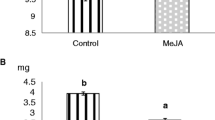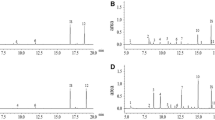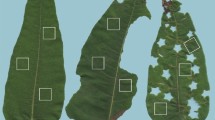Abstract
Elevated levels of CO2, equivalent to those projected to occur under global climate change scenarios, increase the susceptibility of soybean foliage to herbivores by down-regulating the expression of genes related to the defense hormones jasmonic acid and ethylene; these in turn decrease the gene expression and activity of cysteine proteinase inhibitors (CystPIs), the principal antiherbivore defenses in foliage. To examine the effects of elevated CO2 on the preference of Japanese beetle (JB; Popillia japonica) for leaves of different ages within the plant, soybeans were grown at the SoyFACE facility at the University of Illinois at Urbana-Champaign. When given a choice, JB consistently inflicted greater levels of damage on older leaves than on younger leaves, and there was a trend for a greater preference for young leaves grown under elevated CO2 compared to those grown under ambient CO2. More heavily damaged older leaves and those grown under elevated CO2 had reduced CystPI activity, and JB that consumed leaves with lower CystPI activity had correspondingly greater gut proteinase activity. Younger leaves with higher CystPI activity and photosynthetic rates may contribute disproportionately to plant fitness and are more protected against herbivore attack than older foliage. Cysteine proteinase inhibitors are potent defenses against JB, and the effectiveness of this defense is modulated by growth under elevated CO2 as well as leaf position.




Similar content being viewed by others
References
Ainsworth EA et al (2002) A meta-analysis of elevated [CO2] effects on soybean (Glycine max) physiology, growth and yield. Glob Chang Biol 8:695–709
Ainsworth EA, Rogers A, Nelson R, Long SP (2004) Testing the “source-sink” hypothesis of down-regulation of photosynthesis in elevated CO2 in the field with single gene substitutions in Glycine max. Agric For Meteorol 122:85–94
Ainsworth EA, Leaky ADB, Ort DR, Long SP (2008) FACE-ing the facts: inconsistencies and interdependence among field, chamber and modeling studies of elevated [CO2] impacts on crop yield and food supply. New Phytol 179:5–9
Bayes A et al (2005) Structural basis of the resistance of an insect carboxypeptidase to plant protease inhibitors. Proc Natl Acad Sci USA 102:16602–16607
Bernays EA, Chapman RF (1994) Host–plant selection by phytophagous insects. Chapman, New York
Bolter C, Jongsma MA (1995) Colorado potato beetles (Leptinotarsa decemlineata) adapt to proteinase inhibitors induced in potato leaves by methyl jasmonate. J Insect Physiol 41:1071–1078
Botella MA et al (1996) Differential expression of soybean cysteine proteinase inhibitor genes during development and in response to wounding and methyl jasmonate. Plant Physiol 112:1201–1210
Bradford MM (1976) A rapid sensitive method for the quantification of microgram quantities of protein utilizing the principle of protein–dye binding. Anal Bicohem 72:248–254
Broadway RM, Duffey SS (1986) Plant proteinase inhibitors: mechanism of action and effect on the growth and digestive physiology of larval Heliothis zea and Spodoptera exigua. J Insect Physiol 32:827–833
Casteel CL, O’Neill BF, Zavala JA, Bilgin DD, Berenbaum MR, DeLucia EH (2008) Transcriptional profiling reveals elevated CO2 and elevated O3 alter resistance of soybean (Glycine max) to Japanese beetles (Popillia japonica). Plant Cell Environ 31:419–434
Chen Y-F, Etheridge N, Schaller GE (2005) Ethylene signal transduction. Ann Bot 95:901–915
Creelman AR, Mullet JE (1995) Jasmonic acid distribution and actions in plants: regulation during development and response to biotic and abiotic stresses. Proc Natl Acad Sci USA 92:4114–4119
DeLucia EH, Casteel CL, Nabity PD, O’Neill BF (2008) Insects take a bigger bite out of plants in warmer, higher carbon dioxide world. Proc Natl Acad Sci USA 105:1781–1782
Denno RF, McClure MS (1983) Variable plants and herbivores in natural managed systems. Academic, New York, p 717
Dermody O, O’Neill BF, Zangerl AR, Berenbaum MR, DeLucia EH (2008) Effects of elevated CO2 and O3 on leaf damage and insect abundance in a soybean agroecosystem. Arthropod–Plant Interact 2:125–135
Filipova IY, Lysogorskaya EN, Oksenoit ES, Rudenskaya GN, Stepenov VM (1984) L-pyroglutamyl-L-phenylanalyl-L-leucine-p-nitronalide—a chromogenic substrate for thiol proteinase assays. Anal Biochem 143:293–297
Giri AP, Harsulkar AM, Deshpande VV, Sainani MN, Gupta VS, Ranjekar PK (1998) Chickpea defensive proteinase inhibitors can be inactivated by podborer gut proteinases. Plant Physiol 116:393–401
Hamilton JG et al (2005) Anthropogenic changes in tropospheric composition increase susceptibility of soybean to insect herbivory. Environ Entomol 34:479–485
Jongsma MA, Bakker PL, Peters J, Bosch D, Stiekema WJ (1995) Adaptation of Spodoptera exigua larvae to plant proteinase inhibitors by induction of gut proteinase activity insensitive to inhibition. Proc Natl Acad Sci USA 92:8041–8045
Kim JH, Mullin CA (2003) Impact of cysteine proteinase inhibition in midgut fluid and oral secretion on fecundity and pollen consumption of Western Corn Rootworm (Diabrotica virgifera virgifera). Arch Insect Biochem Physiol 52:139–154
Larcher W (2003) Physiological plant ecology: ecophysiology and stress physiology of functional groups. Springer, Berlin
Long SP, Ainsworth EA, Leaky ADB, Nosberger J, Ort DR (2006) Food for thought: lower-than-expected crop yield stimulation with rising CO2 concentrations. Science 312:1918–1921
Morgan PB, Bernacchi CJ, Ort DR, Long SP (2004) An in vivo analysis of the effect of season-long open-air elevation of ozone to anticipated 2050 levels on photosynthesis in soybean. Plant Physiol 4:2348–2357
O’Neill BF, Zangerl AR, DeLucia EH, Berenbaum MR (2008) Longevity and fecundity of Japanese beetle, Popillia japonica (Newman), on foliage grown under elevated CO2. Environ Entomol 37(2):601–607
Prather KA, Guazzotti SA, Suess DT, Pastor SH, Coffee K (2001) New insights into the role of aerosols in affecting pollution and global climate change. Abstr Pap Am Chem Soc 221:U458–U458
Saravitz DM, Siedow JN (1996) The differential expression of wound-inducible lipoxygenase genes in soybean leaves. Plant Physiol 110:287–299
Zavala JA, Baldwin IT (2004) Fitness benefits of trypsin proteinase inhibitor expression in Nicotiana attenuata are greater than their costs when plants are attacked. BMC Ecol 4:11. doi:10.1186/1472-6785-1184-1111
Zavala JA, Baldwin IT (2006) Jasmonic acid signaling and herbivore resistance traits constrain regrowth after herbivore attack in Nicotiana attenuata. Plant Cell Environ 29:1751–1760
Zavala JA, Patankar AP, Gase K, Hui D, Baldwin IT (2004) Manipulation of endogenous trypsin proteinase inhibitor production in Nicotiana attenuata demonstrates their function as anti-herbivore defenses. Plant Physiol 134:1181–1190
Zavala JA, Casteel CL, DeLucia EH, Berenbaum MR (2008a) Anthropogenic increase in carbon dioxide compromises plant defense against invasive insects. Proc Natl Acad Sci USA 105:5129–5133
Zavala JA, Giri AP, Jongsma MA, Baldwin IT (2008b) Digestive duet: midgut digestive proteinases of Manduca sexta ingesting Nicotiana attenuata with manipulated trypsin proteinase inhibitor expression. PLoS ONE 3:e2008. doi:10.1371/journal.pone.0002008
Zhao Y et al (1996) Two wound-inducible soybean cysteine proteinase inhibitors have greater insect digestive proteinase inhibitory activities than a constitutive homolog. Plant Physiol 111:1299–1306
Zucker S, Buttle DJ, Nicklim MJH, Barret AJ (1985) The proteolytic activities of chymopapain, papain and papaya proteinase III. Biochem Biophys Acta 828:196–204
Zvereva EL, Kozlov MV (2006) Consequences of simultaneous elevation of carbon dioxide and temperature for plant-herbivore interactions: a metaanalysis. Glob Chang Biol 12:27–41
Acknowledgments
We thank B. O’Neill, T. Mies and J. Drake for help with field experiments. This work was supported by the Office of Science (Biological and Environmental Research) and the U.S. Department of Energy Grant DE-FG02-04ER63849.
Author information
Authors and Affiliations
Corresponding author
Additional information
Communicated by Andrea Polle.
Rights and permissions
About this article
Cite this article
Zavala, J.A., Casteel, C.L., Nabity, P.D. et al. Role of cysteine proteinase inhibitors in preference of Japanese beetles (Popillia japonica) for soybean (Glycine max) leaves of different ages and grown under elevated CO2 . Oecologia 161, 35–41 (2009). https://doi.org/10.1007/s00442-009-1360-7
Received:
Accepted:
Published:
Issue Date:
DOI: https://doi.org/10.1007/s00442-009-1360-7




